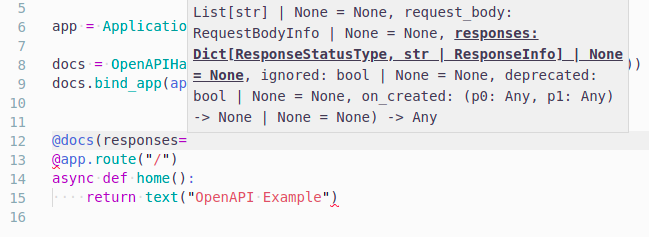Contributing to BlackSheep¶
This page describes how to contribute to BlackSheep. Most of the information
presented here applies also to other projects from
Neoteroi (e.g.
rodi,
guardpost,
essentials-openapi), although
among these projects, only BlackSheep is using Cython.
System requirements¶
Building blacksheep locally requires the following:
- one of the supported Python versions; it is recommended to use one of the latest two stable versions (e.g. Python 3.8 or 3.9 as of the 1st of May 2021)
- a
Ccompiler, required to use Cython (refer to Cython's documentation for more information on this subject)
Preparing a development environment¶
- fork the main repository in GitHub
- clone the forked repository
- create a Python virtual environment in the desired location (
.gitignoresis configured to ignore avenvfolder, so if you name your virtual environment this way, you can comfortably keep the virtual environment in the same folder of the repository) - install the dependencies that are required to develop, listed in
requirements.txt
(pip install -r requirements.txt) - compile the
Cextensions: if your system supportsMakefile, usemake compile; otherwise run manually the commands described in theMakefileforcytandcompilecommands - run the unit tests to verify if things were compiled correctly, using
pytestormake test
Watch the following video for instructions:
Formatters and style enforcement¶
BlackSheep uses the following tools for code formatting:
flake8, black, and isort are used in the CI pipeline as a
required step for successful build completion.
The repository includes configuration files for flake8 and black.
The provided Makefile defines a task to run linters:
make lint- to run flake8, isort, and black validation
Type hints¶
BlackSheep aims at being type friendly, meaning:
- most functions, especially those whose arguments are not obvious, should be type annotated
- when developers work with popular text editors and IDEs like
PyCharmorVisual Studio Code, they should benefit from proper help / auto-completion of parameters required by functions and constructors - the parts coded in
Cythonare documented using stub files (.pyi), see PEP 484 - the code should be generally respectful of
MyPyand, whenVisual Studio Codeis used,Pylance
This being said, blacksheep doesn't aim at 100% typing coverage or full
adherence to MyPy's (or pyright/Pylance's) notions of typing perfection.
The most important thing is for features to work as intended and well (good
enough!), and to be fully test-covered.

Code coverage¶
BlackSheep features 100% code coverage, except for some rare cases where
#pragma: no cover is used. New contributions should not decrease code
coverage, unless there is a good reason to skip lines. Integration with
Codecov checks code coverage
in pull requests.
To create code coverage:
make test-cov
Or, for those who cannot use make:
pytest --cov-report html --cov=blacksheep
How to name branches¶
It doesn't matter, as long as branch names don't contain anything that violates
the Code of Conduct included in the project's repository. As a general rule
of thumb, branch names should have a descriptive name, or refer to the number
of an issue in their name (e.g. fix_102).
setup.py¶
It is the intention of blacksheep's author to always keep setup.py files as
stupid and simple as possible. So please don't modify the setup.py file to
be "smarter" or more dynamic without prior discussion in an issue.
How to develop and debug with Visual Studio Code¶
The following video shows I am using Visual Studio Code to work on BlackSheep:
Last modified on: 2023-12-18 17:52:09

